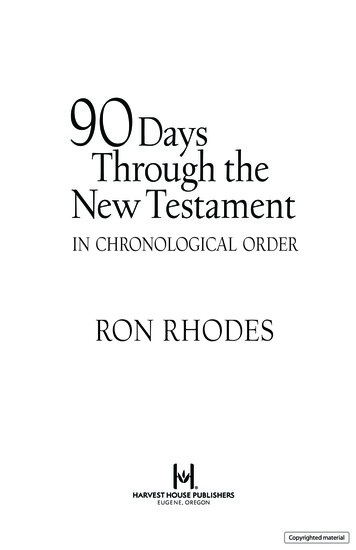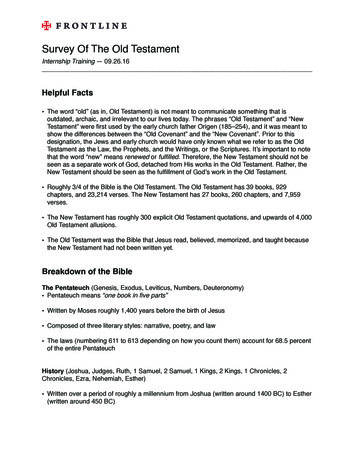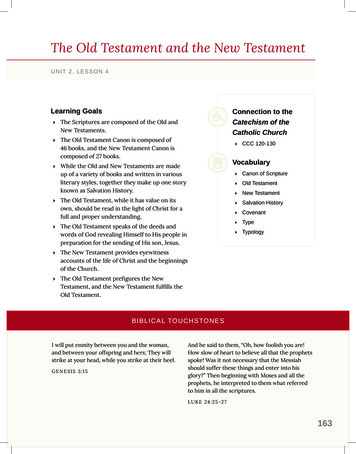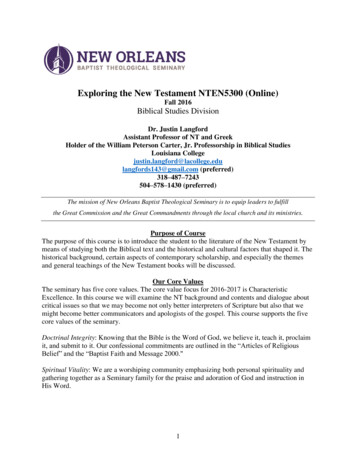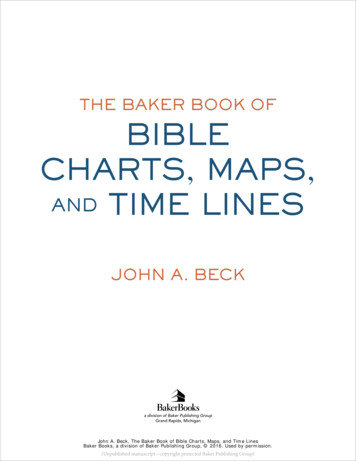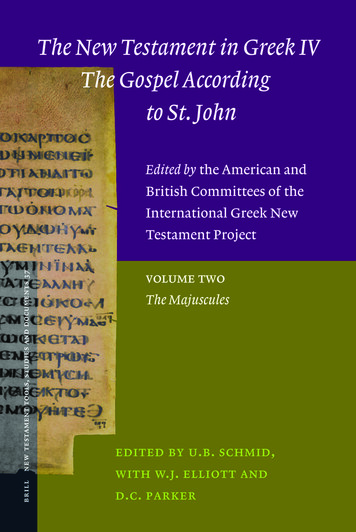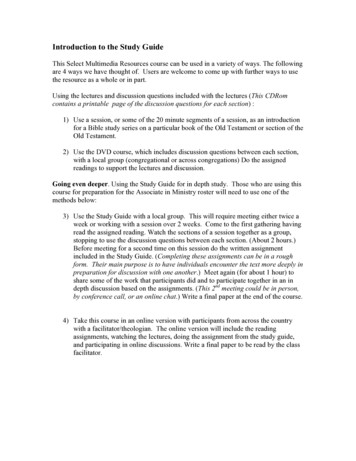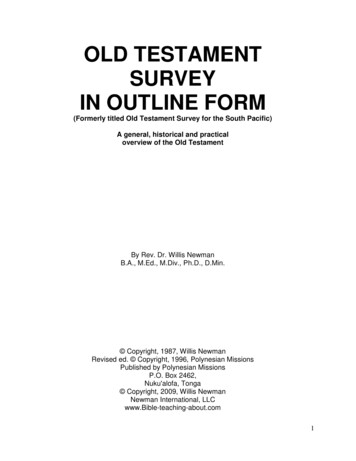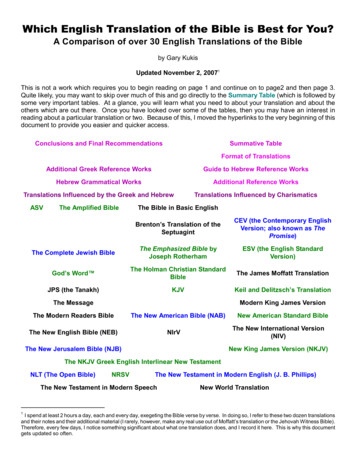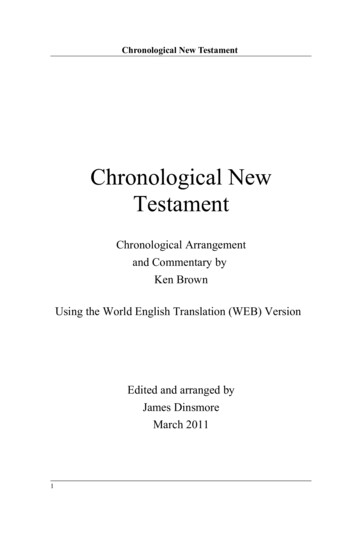
Transcription
Chronological New TestamentChronological NewTestamentChronological Arrangementand Commentary byKen BrownUsing the World English Translation (WEB) VersionEdited and arranged byJames DinsmoreMarch 20111
2
Chronological New TestamentAll scripture is from the World English Bible (WEB)The World English Bible (WEB) is a Public Domain (no copyright)Modern English translation of the Holy Bible. That means that youmay freely copy it in any form, including electronic and print formats.The World English Bible is based on the American Standard Version ofthe Holy Bible first published in 1901, the Biblia Hebraica StutgartensaOld Testament, and the Greek Majority Text New Testament. It is indraft form, and currently being edited for accuracy and readability.(http://ebible.org/, Feb 21, 2011)"World English Bible" and WorldEnglishBible.org are trademarks ofRainbow Missions, Inc. Permission is granted to use the name "WorldEnglish Bible" and its logo only to identify faithful copies of the PublicDomain translation of the Holy Bible of that name published byRainbow Missions, Inc. The World English Bible is not copyrighted.The domain names eBible.org and mpj.cx are trademarks of MichaelPaul Johnson. (http://ebible.org/, Feb 21, 2011)The chronological arrangement of the New Testament and thecommentary was written by Ken Brown and is from his Web ecrying.com/chronology of the new testament.htm, Feb 21, 2011)James Dinsmore simply rearranged the New Testament books using theWorld English Bible (WEB) and formatted them in accordance withKen Brown's chronological order and commentary.The author and editor may be contacted via E-mail:Ken Brownkbrown313@comcast.netJames Dinsmorejamesdinsmore 32907@yahoo.com3
4
Chronological New TestamentPrefaceI embarked on this project to help me overcome the habit of prooftexting or quoting verses out of context. Worse, I have been guilty ofknitting together unrelated verses to 'prove my point'. I am not alone inthis; it is common practice to perform topical searches for Biblicalpassages that match one's agenda or preconceived notions. Suchprofane treatment of the Scriptures has always been the source ofreligious deception. Scripture must be examined in its context to beproperly understood. The original intent, not man's bias, is what isvalid. Much of my conviction in this came from reading, “PaganChristianity” by Frank Viola and George Barna. Chapter 11 of theirbook says it all, “Re-approaching the New Testament: The Bible is Nota Jigsaw Puzzle.” So I set out to retrain my mind by finding achronological New Testament; but could not find one composed in thelast century. The first step was to find someone who could provide anoutline of the scriptural order, which I found in Ken Brown, the authorof this chronology and the attached commentary. Then I had to wadethrough the many modern language renderings of the Bible to find onethat had a copyright permissive enough to allow someone to publish theentire New Testament in an unconventional order. The only open, noncopyrighted modern translation was The World English Bible (WEB).It proved to be readable and accessible for this endeavor. After decadesof studying minute fragments of verses for some new insight I canfinally step back and get a proper view of the message of the NewTestament in its historical context.2 Timothy 2:15 (WEB) Give diligence to present yourself approved byGod, a workman who doesn’t need to be ashamed, properly handlingthe Word of Truth.“ The Bible is Not a Jigsaw Puzzle.” Frank Viola, George BarnaJames Dinsmore, Editor5
6
Chronological New TestamentTHE CHRONOLOGY OF THE NEW TESTAMENTThe Need For A Chronological OrderSeveral years ago while on business I observed a plaque prominentlydisplayed in the foyer of a rather large church building of adenomination I’ll not mention. It read: “Our mission is to carry on therich traditions and meaningful rituals of the church given to us by ourfathers in order to preserve this important religious heritage.” Now, Idon’t mean to be sarcastic (well, maybe I do), but I immediatelythought, “but what about carrying on the rich truths and meaningfulreality given to us by our God in order to preserve what He revealed tous in the Scriptures?” The sad fact of the matter is that man’s religionhas distorted God’s truth to the point that truth is almost lost. I firmlybelieve that when it comes to man dealing with a Holy and RighteousGod and relationship with Him, the tendency of most men is to givemere lip service to what He says and define for themselves theboundaries of that relationship. And our history bears that out. Theresult has been the formation of religion in all its many forms.I also believe that one of the things that has contributed greatly to thesedistortions and to so many different expressions of Christianity is theway the New Testament is presented in our printed Bibles. For over500 years now men have developed a wide variety of traditionalchurches with a Bible made up of numbered sentences (verses) andbooks that are completely out of order when compared to the sequencein which they actually occurred in history. Chronological exposition isunknown and contextualism is practically extinct. Any idea that comesinto the heart of man can be supported or seemingly proven withisolated Scripture verses. That’s why there exist today scores ofdenominations and many other groups the denominations call cults –though, in reality, there are only slight differences between the two.They all claim to have started with the church Jesus founded. And theyall claim to be true to the Scriptures. But, how can that be, since theyare all so different? The New Testament is a record of the developmentof the church in its first 100 years; yet, none of those denominations orcults resembles the church described in the New Testament in even theslightest way!The following is an attempt to put the New Testament in chronologicalorder. I readily admit that some dates may be disputable (men who7
have devoted their lives to such a study do not entirely agree, andabsolute accuracy is really not necessary for our purposes). I’m puttingthe New Testament together in this order because those who want tounderstand the church as Jesus originally founded it will have toforsake most everything they’ve ever learned about “church” as it’sknown in the traditional sense and understand the New Testament andhow it really portrays the Lord’s church. To do this, we must look atthe New Testament as a history of consecutive events and pay closeattention to what those events actually show us.The New Testament is in the same order that you find it in every majortranslation and it has been the same ever since the first one was printedin 1456. It was organized the way you see it because an Augustinianmonk thought this particular order made it easier to study doctrine. Butin this form, it presents an incongruous and disjointed picture of whatreally happened in the church during it’s formative years, making iteasy for men to disregard history and bend it to their own will andpurposes. The result has been gross deception in the formation of manmade religion in all its many structures and beliefs and an almost totaldisregard for what really constitutes Christ’s church.We must compare the church in the New Testament to the traditionalchurch of today, so we can understand why they are not the same thing.Just keep this in the back of your mind for now, the different churcheswe see today in the traditional form that we know them have evolvedover the past 1900 years, with many variations following the samebasic pattern only in slightly different directions (depending on thediffering viewpoints and whims of men), especially since theReformation and the availability of the printed Bible, both of whichcame on the scene in the 15th century. Then, we can use thechronological order of the New Testament that follows to begin tofamiliarize ourselves with what God originally intended for us tofollow as the model for the church.There is one thing for certain: nowhere in the New Testament will youever find even a remote justification for what you see in religion today.There is no blueprint, no instruction given for the religious institutionsthat make up what is called Christianity today. Maybe we should askourselves this question, when Jesus was on this earth, why did He notsettle down in one location and establish what would surely havebecome the first mega-church? Let me venture two reasons. The firstis that it was never His eternal plan. The second is related to the first;8
Chronological New Testamentthe bigger something gets, the less personal it becomes, leading to anineffectiveness that breeds dissention and deception. What happened inJerusalem after Pentecost is a great example, the church started well(Acts 2:41) and with the best of intentions (Acts 2:42-47); but troublecame quickly (Acts 6:1) and God’s remedy was to break it up (Acts8:1).Religious Deception In This AgeJesus predicted with the parable of the mustard seed that His earthlykingdom would be filled with deception. In the Book of Matthew thisearthly kingdom is called the kingdom of heaven (literally, thekingdom from the heaven) and represents the earthly realm ofChristians in this age, beginning with Jesus’ public ministry, throughthe present and continuing on in the future to His second coming.Many of His parables clearly illustrate the fact that this time willcontain both “professing” Christians and true believers. Matthew13:24-30 is the parable of the wheat and tares (tares are a weed thatlooks like wheat, but produces no grain). Here, Jesus explains that bothare allowed to grow in the field together; then the wheat is gathered tothe master’s barn, but the tares are gathered to be burned. In theparable of the dragnet in Matthew 13:47-50 the worthless fish areseparated from the good fish and the worthless fish are thrown away.The symbolism found in these parables and others is clear.The parable of the mustard seed is found in Matthew 13:31-32, Mark4:30-32 and Luke 13:18-19. This is Matthew’s account.“The kingdom of heaven is like a single mustard seed, which a manplanted in his field. Even though it is the smallest of seeds, it growsinto one of the largest plants. And when it is grown, it is the size of atree, and the birds of the air come to live in its branches.”Now remember, parables are comparisons and illustrations. “Thekingdom of heaven is like ” Like what? It’s like the smallest of seedsthat grows up to be one of the largest of plants. The mustard seed isone of the smallest seeds known; so small it’s used as an illustration toemphasize smallness (Matthew 17:20). Yet varieties of this plantcommon to Judea grow into tree-like plants, often 12 feet high. So, thisparable illustrates the smallness of the seed to the greatness of what theseed produces. Jesus’ influence on such a small group of people in arelatively small area surrounding Jerusalem seems insignificant when9
compared to all the people in the whole world. Yet, it quickly led tothe formation of a worldwide religious conglomeration unsurpassed inthe influence and power it has held over people for almost twothousand years now – for both good and bad (but as we’ll see from thisparable, mostly for bad).As in all the parables found in Matthew 13, the man in this parable isJesus. He is the one who planted the seed. Here, as in others using thissymbolism, the seed is the word or message of the kingdom and thefield is the world. Then we get to the part of the parable that religiousleaders would try to explain away. The “birds of the air” that lodge inthe branches of this tree-sized plant are demons. The term used here ispeteinon, “that which is able to fly”, with ouranos, “heavens”, andliterally means “those who are able to traverse the heavens”, areference to demons.This is consistent with what Jesus has already said earlier in the parableof the sower in Matthew 13:3-9, specifically, verse 4 about the seed(the word) that falls by the side of the road being quickly eaten by birdsand in His explanation of this parable that follows in Matthew 13:1823, again, specifically verse 19, where He says the wicked one comesto snatch away or destroy the message. So from this we can concludethe birds in the parable of the mustard seed are the same as the birds inthe parable of the sower, demons under the supervision of Satan, sent tolodge in this worldwide religious conglomeration called the kingdom ofheaven to deceive those who reside there and rob them of truth.And if you remember, then, the parable of the tares follows the sowerand leads up to the mustard seed. Jesus’ illustration of the activitiesand program of Satan is consistent. In His explanation of this parableJesus explains that the tares are the children of the wicked one and theenemy that sowed them is the devil. The good seed (the message of thekingdom) sown by the master (Jesus) produced good wheat (children ofthe kingdom); but the other seed sown by the enemy (religiousdeception) produced something that looked like wheat, but was reallytares or in some translations, darnel (children of the wicked one)(Matthew 13:37-43).There is absolutely no reason to think that these three parables (or theother parables that follow in Matthew 13, as well) are isolated,unrelated stories. Jesus meant for us to compare the illustrationscontained in them in order to understand more fully their meaning andthe characteristics of the kingdom of heaven they describe. And keep10
Chronological New Testamentin mind, the term “kingdom of heaven” is used to describe this currentage of religious profession, a time clearly illustrated by these parableswhen true children of the kingdom live in the same realm with thosewho look like them, but are really the children of the wicked one.Therefore, the birds in the parable of the mustard seed are used toillustrate demons sent by Satan to deceive the inhabitants of thekingdom and steal away the truth. This deception comes in the form ofthe religious systems that make up the kingdom. The “branches” ofthe mustard plant represent all the different religious institutions anddenominations that exist. And the parable of the mustard seed clearlyillustrates the fact that demons lodge in every branch – religiousdeception is not isolated or limited to certain groups, it’s pervasive inthe world. So, let me say it again for emphasis, there is no justificationwhatsoever in the New Testament for any of the religious institutionsthat exist today. They were never what God intended and are aproduct of spiritual deception.The Pattern Must Be RestoredThe purpose of the New Testament was to give us a pattern. When itwas put together the way we know it, that pattern was destroyed.Where there is no pattern to follow, men could make up another to fittheir purposes. And that’s exactly what they’ve been doing. I’mamazed at the number of churches today who claim to be “NewTestament”, but have nothing at all in common with the churchdescribed in the New Testament.Several years ago I was asked my opinion of a rather large singlesministry. It was thought to be successful because it had thousands ofyoung people involved (in religion success is always measured bynumbers). The pamphlet they used to promote their ministry beganwith this statement, “In the absence of a clear model, we set out tocreate our own.” In the absence of a clear model? Give me a break! Inreality it was just another traditional church ministry looking for newand innovative ways to attract more people, while trying to figure outhow to effectively entertain them, so they would enjoy the experienceand come back the next week. And at the same time, slip somethingreligious into the mix, so they’ll think they had some exciting andemotional encounter with God that would make them feel good (thoughthat’s one aspect common to religion I could never quite figure out,11
since those in the Scriptures who actually had an encounter with Godwere frightened, repentant and often fainted).My fervent hope for anyone who reads this chronology is that theywould immerse themselves in the New Testament church that isportrayed by this history that spans approximately 100 years (fromJesus’ birth at 4 BC to the writing of the Book of Revelation at AD 95).As you go through the history of the early church you will seesuffering, sacrifice, hardship, persecution and spiritual opposition,mixed with joy, humor, hope, not a little determination and an almostinconceivable commitment to the cause of Christ. And all of thosethings taken together illustrate one all-important dynamic that I believehas been mostly lost over these past two thousand years of practicedreligion - a true, life-changing reality of Christ in the hearts and lives ofbelievers!And, I believe this reality can only be found in the atmosphere andactivity of His true church. It is a reality of Christ that can only befound in a moment-by-moment relationship with Him, where He is thefirst thing we think about when we wake up in the morning and the lastthing we think about before we go to sleep at night. It is a reality thatmelts our hearts as we experience His love and a reality that makes useager to know His purposes and willing to obey His every word. Areality that demonstrates the depths of His kindness and mercy, thescope of which constantly amazes us. The reality of a Lord that is sogreat that we know our constant praise of Him will never adequatelydefine His greatness! A reality that takes us from glory to glory(actually from one personal experience to the next), transforming usinto His wonderful image and a reality of Christ that constrains andconsumes us. Then finally, it is a reality that causes us to know withcertainty that His church is not comprised of some group that meetstogether on Sunday morning in the big building on the corner to enjoytheir multimedia presentation, promote their programs and perpetuatetheir traditions and rituals. It is, instead, made up of people all overthe world who meet with Him continually and individually, striving tomaintain a personal relationship of intimacy with Him.Real Faith Is Defined By Personal ExperienceAs has been my habit over the years, I like to examine Scripture versesfrom various translations to make sure the grammar and word meanings12
Chronological New Testamentare accurate, and then put them in more contemporary English. Thefollowing is my expanded paraphrase of II Corinthians 13:5 and isintended to serve as an earnest challenge to all who read this.“Evaluate your life and see if you’re holding to true faith. Do you seethe proof, the reality of it? Have you not yet realized by an everexpanding personal experience that Christ is in you (motivating anddirecting your life)? If that is not the case, you have failed the test.”You might want to stop here and read that verse a few more times. Thepoint I’m making here is that we tend to read something translated fromone language (in this case, Greek) to another (English) and tend to missor overlook the full meaning of what is being said. Part of this is thereligious bias of translators; part of it is the weakness of the Englishlanguage when only a few words are used. This is why we havelibraries full of commentaries and other study helps written to help usunderstand the meanings of the Hebrew and Greek words found in theScriptures.If you did as I asked and read that verse several times, hopefully yourealized the connection between “faith” and “personal experience”.True faith is defined by the real experiences we have with Him thatchange us and make us more like Him. It cannot be the result oflearning a denomination’s “statement of faith” (more accurately, astatement of belief). It does not come from listening to someone elsetalk about Him week after week. It is not something that automaticallyresults from singing songs specifically crafted to elicit an emotionalresponse. It is not found in following religious traditions and ritualsthat are not reality, but mere representations of it. Faith is notsomething that automatically comes from a perfect attendance record inSunday School. Faith is never defined by adherence to a list of rulesthat represent a particular group’s moral standards (do this, don’t dothat, etc), standards that can vary significantly from group to group.Look at the Scriptures; Hebrews 11 is the great “faith” chapter. It talksabout the faith of Abel, Enoch, Noah, Abraham, Sarah and others. But,when you look at what is actually written about them, it is a record oftheir real experiences with God. Hebrews 11:6 explains the principle.“But without faith (real experiences) it is impossible to please God,because anyone who wants to be close to God (in relationship withHim) must not only believe that He exists, but that He will (personally)respond to those who diligently seek Him.” (My paraphrase) Theirfaith was borne out of their desire to know God, their diligence in13
seeking Him and His response that resulted in their experiences withHim. And that is what is illustrated over and over in the Scriptures.This Is My ExperienceLet me explain something the Father taught me several years ago thatchanged my life dramatically. I come from a fundamentalist Baptistbackground. And one of the things they always said was, “The Bible isour only source of faith and practice”. But the Father led me tounderstand that He is my source of faith (again, real experiences) andpractice. The Father wants to teach me what is right and true, and thenHe will hold me accountable as I struggle to apply it to my life. Andthe Bible is where I can confirm those things by seeing the experiencesof others in the past are similar to mine. The Bible doesn’t tell me whatto do, He does! The Bible only reassures me that others have hadexperiences resembling my own.Let me try to illustrate this principle of going to the Scriptures toconfirm our experiences with God. Several years ago I walked awayfrom religion frustrated and disillusioned. I wanted to know God, butimmersed in religion as I was, it was becoming more and more clear tome that I didn’t. Slowly, but surely, over those 35 years in traditionalministry, I was beginning to realize that religion just didn’t deliver aspromised. Why it took that long for me to figure it out, God onlyknows. But I finally began to understand that I didn’t know Him in theway that I should, and that what religion called a personal relationshipwith God was not really personal nor could it be called a relationship.So, I quit the church, isolated myself and began to cry out to God. Andas God began to reveal Himself to me, the more He taught me aboutHimself, the more I understood why God and religion is not the samething. What you’re reading here is nothing more than my feeble,disjointed attempts to communicate what He’s teaching me aboutHimself, about me and about the deception of religion. As I began tospend time alone with Him, eventually He brought to my mind sometimes in the past that I had (somewhat arrogantly) prayed and said Iwanted to be known as a man who walked with God. And this is whatHe taught me about walking with Him: if you want to learn how towalk with God, you must first learn to talk to Him. This is thefoundation of any relationship and our relationship with God is no14
Chronological New Testamentdifferent! Then, as we talk to Him and He responds, our experienceswith Him define our faith.What do I mean when I say you must learn to talk to God? Again, thisis my experience. I had to learn to be honest with God and expressmyself openly to Him. And you can be sure; this was a new experiencefor me. I knew how to close my eyes and thank Him for my foodbefore meals (if someone else was present and expected me to). I knewhow to recite general, religious-sounding public prayers in churchservices (because it was in the program and part of my job). I knewhow to tell God what to do, how to do it and who to do it to in so-called“ministry” times (so people could hear what they wanted to hear andfeel better about themselves or their circumstances). And from time totime, as is required of religious leaders, I got out my long laundry listof prayer requests and told God how I wanted Him to manipulate otherpeople or situations so they would line up with what I thought was best(though I could never quite figure out why I bothered, because thingsrarely turned out the way I thought they should).But God began to destroy all that foolishness. And as He tore down thereligion, reality began to set in. I began to learn how to talk to Himabout things that actually mattered. I began to learn that God wasn’tinterested in what I thought or what I had to say about others. I learnedthat when I was in the presence of a Holy and Righteous God, all Icould do was submit to Him and agree with Him. I began to realizethat when I got alone with God, He wanted to know what I thoughtabout myself. Ouch! And as uncomfortable as that was, His gentlelove and acceptance of my repentant heart made those timesirresistible. I was drawn to Him like a moth to the flame. But I learnedthe flame didn’t destroy, it only refined and changed. I experiencedone of those ironies that can only be true in God, the pain felt good.Slowly, but surely, to the degree that I was able (or willing) to submitto Him and obey; He was conforming me to the image of His Son.Jesus Is The ExampleSo, I repeat, if you want to learn how to walk with God, you have tolearn how to talk to Him. Now, how do I know that’s true? Tworeasons. The first is that it has been my experience, my reality,literally, my faith. The second is that I can go to the Scriptures andconfirm it, because it was the experience of men in both the Old and15
New Testaments. But, I’m not going to belabor the point. I’ll justshow you Jesus. He’s the example of talking to God; He’s the exampleof faith being defined by personal experiences. Let me clue you in onsomething. When you experience God, you can usually confirm thereality of it by looking at Jesus.I sometimes have to stop to chase a rabbit or two. I’ll make this short.Hebrews 12:2 tells us to, “Carefully consider Jesus, the Author andFinisher of our faith”. “Author” is from archegos, meaning,“originator”. He set the example for us to follow. “Finisher” isteleiotes, “the one who brings something through to the goal”. He hada relationship with the Father based on His personal experiences withHim (real faith); then (when His work was through) He went to be withthe Father. Jesus showed us both the example to follow and the resultof following it.What did Jesus show us? “And after He had dismissed the crowd, Hewent up into the hills by Himself to pray. And when evening came, Hewas still there.” (Matthew 14:23, my paraphrase, compare Mark 1:35;Luke 5:16, 6:12, 9:18, 11:1) As you go through the Gospel accountsyou will see it was Jesus’ habit to spend time alone talking with theFather. As a result He experienced the Father’s presence and learnedWho He was and what the Father wanted Him to do. This is John 8:28.“Then Jesus said, After you have lifted up the Son of Man (on a cross),you will understand that I am the One you seek and I do nothing on Myown authority, but I say only what My Father has taught Me.” (Myparaphrase, read John 5:19, 30; 8:26, 38 for other examples) Can wenot conclude that Jesus is our example of how to have a realrelationship with God?This is the pattern that must be followed. Jesus spent time talking tothe Father. The Father responded. Jesus submitted and obeyed, sayingwhat the Father told Him to say and doing what the Father told Him todo. Can there be any doubt that Paul and others in the New Testamenthad the same kind of relationship? Was it any different for Abraham,Moses, David or any of the others we see in the Old Testament? I seeno evidence that would convince me of that.And is there any reason why we should think it would somehow bedifferent for us today? Did God change? Does He respond to usdifferently than He did to Jesus or others in the Scriptures? Should wesubscribe to the nonsense common in religion today that God onlyspeaks to us through the Scriptures? Should we believe that God only16
Chronological New Testamentspeaks to us today through the traditions and rituals of long-establishedreligious institutions? Or, worse yet, should we believe that God onlyspeaks to us through a chosen few religious leaders? Not if youactually believe the Scriptures. “For I Am the Lord, I will not change.”(Malachi 3:6, my paraphrase, see also James 1:17). And not if youbelieve what Jesus says, “It is written in the Prophets, And they shallall be taught by God (have Him as their personal Teacher). Andeveryone who listens to Him and learns, will come to Me.” (John 6:45,my paraphrase, Jesus is quoting Isaiah 54:13) That looks like Godrelating to believers on an individual, personal basis, just like He didwith Jesus and others we see in the Bible. That looks like personalexperience to me. And, in my own experience I can say it is also a lifechanging reality.It’s A Matter Of PerspectiveAnd if what I have presented in these last couple of paragraphs is true,the question begs to be asked: what is the purpose of all the religiousgroup activities, the programs, the professional clergy and the bigbuildings they meet in? Like everything else, it becomes a matter ofperspective. If you look at the New Testament assuming thateverything there supports all this religious activity, then that is whatyou will probably follow. But if you look at it from a perspective thatnothing there supports this religious activity, your point of view mightchange.Here’s an example of this perspective. People always ask me, whatabout the verse that talks about not forsaking the assembling ofourselves together? You tell me. Does Hebrews 10:25 specifically
book says it all, “Re-approaching the New Testament: The Bible is Not a Jigsaw Puzzle.” So I set out to retrain my mind by finding a chronological New Testament; but could not find one composed in the last century. The first step was to find someone who could provide an outline of the
